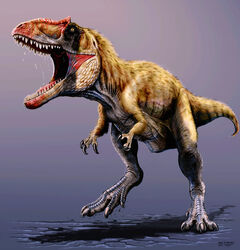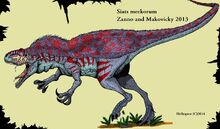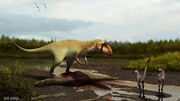| Siats | |
|---|---|

| |
| An artist's interpretation of Siats meekerorum | |
| Scientific classification | |
| Kingdom: | Animalia |
| Phylum: | Chordata |
| clade: | Dinosauria |
| Order: | Saurischia |
| Suborder: | Theropoda |
| Genus: | †Siats Zanno & Makovicky, 2013 |
| Species: | †S. meekerorum |
| Binomial name | |
| †Siats meekerorum Zanno & Makovicky, 2013 | |
Siats meekerorum, meaning Man-Eating Monster, was the apex predator of the Cenomanian Stage. It was named after a man eating monster and the Meeker family, who are museum donors. Holotype specimen is found in Utah, Ceder Mountain formations, which also gave us well-known Deinonychosaurids - Utahraptor and Deinonychus. Holotype is also only known specimen from this genus, discovered by paleontologist Lindsay Zanno in year 2009. Skeleton includes traces of wide, crocodillian - shaped teeth. Dr. Zanno thinks that is a clue that giant crocodiles, possibly even Deinosuchus roamed this landscape. Today, Siats is generally known for being the fourth largest terrestial carnivore North America has ever known, and the largest of the Megaraptora clade.
General Description
~Classification~
First when we discovered the skeleton, we thought it belongs to carcharodontosaurid type of dinosaur, possibly close related to Acrocanthosaurus or Schaochilong. Later and closer analysis of skull shape revealed that this dinosaur is rather neovenatorid than carcharodontosaurid. Speculations about classification of this species are still out, so theories that this dinosaur may be a Maniraptoran or Megaraptoran (type of Tyrannosauroid) arrived in year 2014.
Size

Holotype specimen is about 9 m long and 3.5m tall, what's pretty large to neovenatorid standards. However, Dr. Lindsay Zanno says that holotype did not belong to an adult, but to the juvenile. She also says this dinosaur can be about 4.5m tall at most and about 12 m long, what surely makes him one of the largest predators in North America. It is still amazingly large.
Hunting tactics and behavior
In early Cretaceous, there were no known large predators, until now. Tyrannosauroids were small, about the size of a lion or a dog. Only larger species were Lythronax and Teratophoneus, but they were also small for Tyrannosauroid standards. Also, large herbivores dominated in this environment, and these small Tyrannosaurs could not hunt them. Now, we have found answers - Siats Meekerorum was natural predator of gigantic sauropds, but he was also the reason why Tyrannosauroids were so small and swift. They evolved gracile and aerodynamic design of thorax and body at all, alongside with long legs, with very large metatarsals and obviously smaller "upper leg" (tibia and femur). Also, tibia was a bit longer than femur. This was leg design perfect for very fast running on long distances. They are actually not able to hunt well- because of their small size, so they evolved these legs to escape from Siats and his cousins, what indicates Siats did not eat just large Sauropds such as Cedarosaurus, but and Tyrannoauroids. On other side, like most of Allosaurs, Siats was slow creature and partially scavenger. However, because of his emu-like design of hindlimbs, he was able to run pretty fast on short distances. When Siats and similar theropods died off about the begining of middle Cretaceous, Tyrannosaurids were finally able to grow to immense sizes and dominate the landscape.
